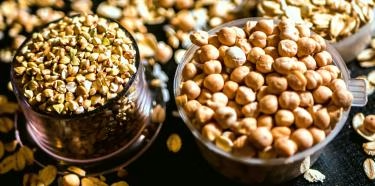While most people are familiar with oatmeal as porridge, oatmeal actually has many different cooking uses, which we’ll explore today.
First, let’s understand the difference between traditional oatmeal and instant oatmeal.
The Difference Between Traditional and Instant Oatmeal
Both traditional and instant oatmeal require the oats to be hulled, rolled, and sliced to create the flat oatmeal. In other words, both require some processing.
However, the degree of processing differs. To make instant oatmeal easier to cook, it’s pressed thinner, cut smaller, and finer. Therefore, instant oatmeal can be eaten simply by soaking it in hot water, unlike traditional oatmeal, which needs to be boiled for about five minutes. However, traditional oatmeal retains more fiber and other nutrients.
Now that we’ve explained the differences between traditional oatmeal and instant oatmeal, let’s take a look at all the recipes you can use oatmeal in.
Oatmeal Cookies Recipe
Using oatmeal as one of the ingredients in your cookies will give you a rich source of dietary fiber. For oatmeal cookies, refer to the recipe below, but this recipe requires an oven.
If you don’t have an oven, you can try the no-bake “Chocolate Oatmeal Cookies” recipe below.
Ingredients:
- 2 cups granulated sugar
- 1 stick butter
- 1/2 cup low-fat milk
- 1/3 cup unsweetened cocoa powder
- 3 cups rolled oats
Instructions:
- In a small saucepan, combine granulated sugar, butter, milk, and cocoa powder. Bring to a boil over medium heat. Stirring occasionally to prevent burning.
- Boil for 3 minutes before removing from heat. Remove the saucepan from the stove and pour the rolled oats into the saucepan.
- After evenly mixing all the ingredients in the pan to form a chocolate oatmeal batter, use a spoon to scoop small portions onto baking paper. Wait until the batter begins to firm up and you’re done!
Oatmeal Bread and Oatmeal Cake
In addition to cookies, oatmeal can also be used in bread and cakes. It’s usually ground into a powder before use. Oatmeal powder can be mixed with flour or used entirely in place of flour. Also, while oatmeal contains gluten, gluten-free oatmeal or oat flour are available.
Oatmeal Muffins
Replacing flour with oatmeal in muffins provides a good source of dietary fiber and makes this delicate dessert even healthier. Remember the banana muffins that were all the rage a while ago? They were made with bananas and eggs. Because they didn’t contain flour, they had a very different taste and texture. If you find them unpalatable, try adding oatmeal as a third ingredient. Not only will they be more delicious, but they’ll also be more nutritious.
Oatmeal Soups and Stews
If your soup or stew isn’t thick enough to your liking, add 1-2 tablespoons of oatmeal and simmer over medium-low heat for 5-10 minutes, until the consistency is as desired.
This method uses oatmeal’s ability to thicken when mixed with hot water, turning it into a natural thickener that can change the texture of any soup or stew.


Leave a Reply